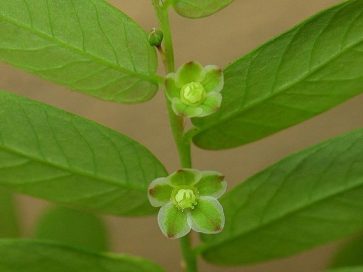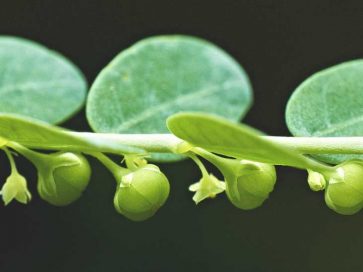What is chancapiedra?
The chancapiedra (Phyllanthus niruri) is a medicinal plant, herbaceous, belonging to the family of the Euphorbiaceae. These are small shrubs, measuring about 45 centimeters, have small leaves of intense green color, small flowers, greenish white, and fruits of 2 millimeters in diameter, in a capsule. It grows in different regions of the world, in tropical and rainy climates, such as India, China, and the Amazonian regions of Ecuador, Brazil, Colombia and Venezuela. Within Peru, it is common to find it in the jungle area, especially in the departments of Amazonas, Cajamarca, Cuzco, Loreto and San Martin, at altitudes between 500 and 3000 meters above sea level.
It is an important component in traditional medicine of the countries mentioned, so it has various names, such as quiebrapiedras, quebrapedras, barbasquillo, St. Paul’s herb, among others. The property for which it is best known is its ability to dissolve kidney stones and prevent the formation of new ones, in addition to being anti-inflammatory, hepatoprotective, antioxidant, and it is believed that it could have effects on the virus that causes AIDS and on the hepatitis B.

What are its properties?
The active components to which the properties of this plant are due are lignans, tannins, coumarins, terpenes, flavonoids, alkaloids, saponins and phenylpropanoids, among others, mainly isolated from leaves, stems and roots. The whole plant has medicinal utility. The lignans and terpenes give it its hepatoprotective, antioxidant quality, avoiding the formation of components capable of damaging the tissues of the liver. Flavonoids are responsible for their anti-inflammatory function, relaxing the muscles of the urinary tract, and also strengthen the walls of blood capillaries, which may be useful in people with cardiovascular and circulation problems. On the other hand, they provide diuretic properties.
Kidney stones are formed from calcium oxalate crystals, which are deposited in the urinary tract by various factors. Several studies showed that the chancapiedra extract has the properties of inhibiting the agglomeration of calcium oxalate crystals, preventing the formation of new stones; and also to help dissolve the calculations already formed. Being anti-inflammatory, it helps in the relaxation of the muscles of the urinary channels for an easier expulsion of the stones, with less pain. On the other hand, it is diuretic, which stimulates kidney function.
Chancapiedra composition:
Lignano (they are one of the two main groups of phytoestrogens, which are antioxidants) triterpenes, alkaloids, alkanes, vitamin c, tannins and saponins among others.
What benefits does it have on health?
1) It contributes to the dissolution of kidney stones and to prevent new ones from forming, since it acts on the crystals that accumulate in the urinary system. It protects the urinary tract and kidneys, eliminates obstructions and works as a diuretic, improving kidney activity.
2) It is an antioxidant, so it protects the body’s cells from components that can damage them.
3) Protects and detoxifies the liver, as it helps to reduce the fat content in it, avoiding complications such as fatty liver or atherosclerosis.
4) It is anti-inflammatory, which can help if there are kidney stones, since it relaxes the muscles of the urinary tract, helping to eliminate the stones and to reduce the pain they cause.
5) It has disinfecting effects and could act on intestinal parasites and others that affect domestic animals.

A little history
The history of chancapiedra in traditional medicine is very extensive: There are records of its use in ayurveda (traditional medicine of India, which takes into account the confluence of body-mind and spirit when it comes to healing) for more than 2000 years, in traditional Chinese medicine and jamu in Indonesia (medicine from natural components, both vegetables and animals). The uses documented in antiquity have to do with treatments of jaundice, genital infections, diabetes, diarrhea and liver diseases.
In Peru, the use by the Incas is registered as infusions to treat liver pains and intestinal diseases.
At present, its use is being investigated to manufacture medicines for certain types of cancer, hepatitis B and HIV (Human Immunodeficiency Virus).
Recipes
It can be drunk as a chancapiedra infusion, three times a day. Add 10 grams of dry stone chanca in a liter of boiling water. Let it rest for 5 to 10 minutes, strain and drink warm, preferably without adding sugar. At first it may have a bitter taste, but then it softens. There are also drops and chancapiedra capsules made by the pharmaceutical industry from chancapiedra powder and chancapiedra extract, which have their own dosage recommendation according to the concentrations to which they have been manufactured. In general, they are usually eaten on an empty stomach or before each meal, with plenty of water.
Although no adverse effects or toxicity were reported in its use, it is not recommended in pregnant or lactating women, or in children under 6 years, and it is preferable that after 3 months of consumption, “pauses” of 2 to 3 weeks before returning to start the treatment.





